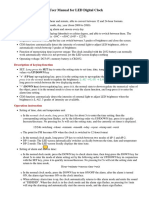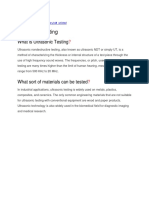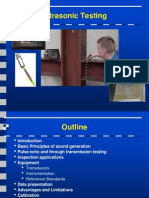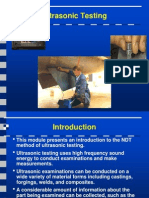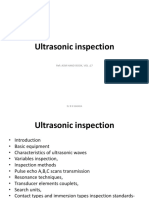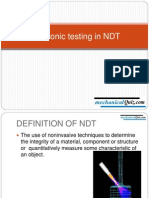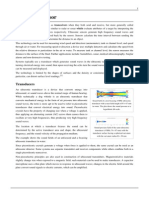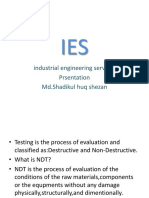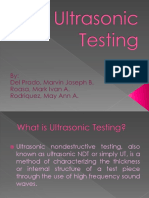Module 4 Ultrasonictesting and AE Testing
Uploaded by
ujwalroy119Module 4 Ultrasonictesting and AE Testing
Uploaded by
ujwalroy119Non –Destructive Testing and Evaluation (18ME823) Module 4: Ultrasonic Testing and Acoustic emission
MODULE 4 ULTRASONIC TESTING AND ACOUSTIC EMISSION
ULTRASONIC TESTING
Introduction
Ultrasonic Inspection is a nondestructive method in which beams of high-frequency sound waves are
introduced into materials for the detection of surface and subsurface flaws in the material. The sound waves
travel through the material with some attendant loss of energy (attenuation) and are reflected at interfaces.
The reflected beam is displayed and then analyzed to define the presence and location of flaws or
discontinuities.
Ultrasonic testing uses the same principle as is used in naval SONAR and fish finders. Ultra-high
frequency sound is introduced into the part being inspected and if the sound hits a material with a different
acoustic impedance (density and acoustic velocity), some of the sound will reflect back to the sending unit
and can be presented on a visual display.
By knowing the speed of the sound through the part (the acoustic velocity) and the time required for
the sound to return to the sending unit, the distance to the reflector (the indication with the different acoustic
impedance) can be determined. The most common sound frequencies used in UT are between 1.0 and 10.0
MHz, which are too high to be heard and do not travel through air. The lower frequencies have greater
penetrating power but less sensitivity (the ability to "see" small indications), while the higher frequencies
don't penetrate as deeply but can detect smaller indications.
Most ultrasonic inspection instruments detect flaws by monitoring one or more of the following:
➢ Reflection of sound from interfaces consisting of material boundaries or discontinuities within the metal.
➢ Time of transit of a sound wave through the testpiece from the entrance point at the transducer to the
exit point at the transducer
➢ Attenuation of sound waves by absorption and scattering within the testpiece
➢ Features in the spectral response for either a transmitted or a reflected signal
Most ultrasonic inspection is done at frequencies between 0.1 and 25 MHz--well above the range of
human hearing which is about 20 Hz to 20 kHz. Ultrasonic waves are mechanical vibrations where the
amplitudes of vibrations in metal parts being ultrasonically inspected impose stresses well below the elastic
limit, thus preventing permanent effects on the parts.
Principle
The two most commonly used types of sound waves used in industrial inspections are the
compression (longitudinal) wave and the shear (transverse) wave, as shown in Figure.
Compression waves cause the atoms in a part to vibrate back and forth parallel to the sound direction
and shear waves cause the atoms to vibrate perpendicularly (from side to side) to the direction of the
sound. Shear waves travel at approximately half the speed of longitudinal waves.
Sound is introduced into the part using an ultrasonic transducer ("probe") that converts electrical
impulses from the UT machine into sound waves, then converts returning sound back into electric impulses
that can be displayed as a visual representation on a digital or LCD screen (on older machines, a CRT
screen). If the machine is properly calibrated, the operator can determine the distance from the transducer to
the reflector, and in many cases, an experienced operator can determine the type of discontinuity (like slag,
porosity or cracks in a weld) that caused the reflector.
Because ultrasound will not travel through air (the atoms in air molecules are too far apart to transmit
ultrasound), a liquid or gel called "couplant" is used between the face of the transducer and the surface of the
part to allow the sound to be transmitted into the part.
Department of Mechanical Engineering, MIT Mysore 1
Non –Destructive Testing and Evaluation (18ME823) Module 4: Ultrasonic Testing and Acoustic emission
Ultrasonic inspection methods or techniques (Transmission and Pulse echo methods)
The 2 major methods of ultrasonic inspection are the transmission method and the pulse-echo method.
1. Transmission method-It involves only the measurement of signal attenuation
2. Pulse-echo method- It can be used to measure both transit time and signal attenuation.
Transmission Method
The transmission method includes either reflection or through transmission. It involves only the
measurement of signal attenuation. This method is also used in flaw detection. Through-transmission testing
uses an emitter to send the ultrasound waves from one surface and a separate receiver to receive the sound
energy that has reached the opposite side of the object. Imperfections in the material reduce the amount of
sound that is received, allowing the location of flaws to be detected.
Fig 1: Transmission method Fig2 : Pulse-echo method
Pulse echo method
The pulse-echo method, which is the most widely used ultrasonic method which involves the detection
of echoes producedwhen an ultrasonic pulse is reflected from a discontinuity or an interface of a testpiece.
This method is used in flaw location and thickness measurements.
➢ Flaw depth is determined from the time-of-flight between the initial pulse and the echo produced by
a flaw. Flaw depth might also be determined by the relative transit time between the echo produced
by a flaw and the echo from the back surface.
➢ Flawsizes are estimated by comparing the signal amplitudes of reflected sound from an interface
(either within the testpiece or at the back surface) with the amplitude of sound reflected from a
reference reflector of known size or from the back surface of a testpiece having no flaws.
a. Straight Beam Method
Straight beam inspection uses longitudinal waves to
interrogate the test piece as shown at the right. If the sound
hits an internal reflector, the sound from that reflector will
reflect to the transducer faster than the sound coming back
from the back-wall of the part due to the shorter distance
from the transducer. This results in a screen display like
that shown in graph. Digital thickness testers use the same
process, but the output is shown as a digital numeric readout
rather than a screen presentation.
b. Angle Beam Method
Angle beam inspection uses the same type of transducer but it is mounted on an angled wedge (also
called a "probe") that is designed to transmit the sound beam into the part at a known angle. The most
commonly used inspection angles are 45o, 60o and 70o, with the angle being calculated up from a line drawn
through the thickness of the part (not the part surface). A 60o probe is shown in figure. If the frequency and
wedge angle is not specified by the governing code or specification, it is up to the operator to select a
combination that will adequately inspect the part being tested.
Department of Mechanical Engineering, MIT Mysore 2
Non –Destructive Testing and Evaluation (18ME823) Module 4: Ultrasonic Testing and Acoustic emission
Immersion Testing
Immersion Testing is a technique where the part is immersed in a tank of water with the water being
used as the coupling medium to allow the sound beam to travel between the transducer and the part. The UT
machine is mounted on a movable platform (a "bridge") on the side of the tank so it can travel down the
length of the tank. The transducer is swivel-mounted on at the bottom of a waterproof tube that can be
raised, lowered and moved across the tank. The bridge and tube movement permits the transducer to be
moved on the X-, Y- and Z-axes.
All directions of travel are gear driven so the transducer can be moved in accurate increments in all
directions, and the swivel allows the transducer to be oriented so the sound beam enters the part at the
required angle. Round test parts are often mounted on powered rollers so that the part can be rotated as the
transducer travels down its length, allowing the full circumference to be tested. Multiple transducers can be
used at the same time so that multiple scans can be performed.
Phased Array
Phased array inspections are done using a probe with multiple elements that can be individually
activated. By varying the time when each element is activated, the resulting sound beam can be "steered",
and the resulting data can be combined to form a visual image representing a slice through the part being
inspected.
Time of Flight Diffraction
Time of Flight Diffraction (TOFD) uses two transducers located on opposite sides of a weld with the
transducers set at a specified distance from each other.
One transducer transmits sound waves and the other transducer acting as a receiver. Unlike other
angle beam inspections, the transducers are not manipulated back and forth towards the weld, but travel
along the length of the weld with the transducers remaining at the same distance from the weld. Two sound
waves are generated, one travelling along the part surface between the transducers, and the other travelling
down through the weld at an angle then back up to the receiver. When a crack is encountered, some of the
sound is diffracted from the tips of the crack, generating a low strength sound wave that can be picked up by
the receiving unit. .
Department of Mechanical Engineering, MIT Mysore 3
Non –Destructive Testing and Evaluation (18ME823) Module 4: Ultrasonic Testing and Acoustic emission
Data representation or Presentation of Pulse-Echo Data
Information from pulse-echo inspection can be displayed in different forms. The basic data formats include:
1. A-scans: This format provides a quantitative display of signal amplitudes and time-of-flight data
obtained at a single point on the surface of the testpiece. The A-scan display, which is the most widely
used format, can be used to analyze the type, size, and location (chiefly depth) of flaws
2. B-scans:This format provides a quantitative display of time-of-flight data obtained along a line of the
testpiece. The B-scan display shows the relative depth of reflectors and is used mainly to determine
size (length in one direction), location (both position and depth), and to a certain degree the shape and
orientation of large flaws
3. C-scans:This format provides a semiquantitative or quantitative display of signal amplitudes obtained
over an area of the testpiece surface. This information can be used to map out the position of flaws on
a plan view of the testpiece. AC-scan format also records time-of-flight data, which can be converted
and displayed by image-processing equipment to provide an indication of flaw depth
1. A-Scans
A-scan display is basically a plot of amplitude versus time, in which a horizontal baseline on an
oscilloscope screenindicates elapsed time while the vertical deflections (called indications or signals)
represent echoes (Fig). Flaw size can be estimated by comparing the amplitude of a discontinuity signal
with that of a signal from a discontinuity of known sizeand shape; the discontinuity signal also must be
corrected for distance losses.
Fig: Block diagram of an analog A-scan setup, including video-mode display, for basic pulse-echo ultrasonic inspection
2. B Scan
B-scan display is a plot of time versus distance, in which one orthogonal axis on the display corresponds to
elapsed time, while the other axis represents the position of the transducer along a line on the surface of the
testpiece relative tothe position of the transducer at the start of the inspection. Echo intensity is not measured
directly as it is in A-scan inspection, but is often indicated semiquantitatively by the relative brightness of
echo indications on an oscilloscope screen. A B-scan display can be likened to an imaginary cross section
through the testpiece where both front and back surfaces are shown in profile. Indications from reflecting
interfaces within the testpiece are also shown in profile, and the position, orientation, and depth of such
interfaces along the imaginary cutting plane are revealed.
Fig: Typical B-scan setup, including video-mode display, for basic pulse-echo ultrasonic inspection
Department of Mechanical Engineering, MIT Mysore 4
Non –Destructive Testing and Evaluation (18ME823) Module 4: Ultrasonic Testing and Acoustic emission
3. C Scan
C-scan display records echoes from the internal portions of testpieces as a function of the position of each
reflectinginterface within an area. Flaws are shown on a readout, superimposed on a plan view of the
testpiece, and both flaw size (flaw area) and position within the plan view are recorded. Flaw depth normally
is not recorded, although it can be measured semiquantitatively by restricting the range of depths within the
testpiece that is covered in a given scan. With an increasing number of C-scan systems designed with on-
board computers, other options in image processing and enhancement have become widely used in the
presentation of flawdepth and the characterization of flaws. An example of a computer-processed C-scan
image is shown in Fig. 11, in which a graphite-epoxy sample with impact damage was examined using time-
of-flight data. The depth of damage is displayed with a color scale in the original photograph.
Fig: Typical C-scan setup, including display, for basic pulse-echo ultrasonic immersion inspection
Applications
➢ The A-scan display is not limited to the detection and characterization of flaws; it can also be used for measuring
thickness, sound velocities in materials of known thickness, attenuation characteristics of specific materials, and
beam spread of ultrasonic beams. Commercial instruments are usually adequate for these purposes, as well as for
detecting the small cracks, porosity, and inclusions that are within the limits of resolution for the particular
instrument and inspection technique. In addition to conventional single-transducer pulse-echo inspection, A-scan
display can be used with transmission or reflection techniques that involve separate sending and receiving
transducers.
➢ The B-scan presentations is their ability to reveal the distribution of flaws in a part on a cross section of that part.
Although B-scan techniques have been more widely used in medical applications than in industrial applications,
B-scans can be used for the rapid screening of parts and for the selection of certain parts, or portions of certain
parts, for more thorough inspection with A-scan techniques. Optimum results from B-scan techniques are
generally obtained with small transducers and high frequencies.
➢ C-scan systems, particularly automatic units, incorporate additional electronic gating circuits for marking,
alarming, or charting. These gates can record or indicate information such as flaw depth or loss of back reflection,
while the main display records an overall picture of flaw distribution.
Transducer Elements
The generation and detection of ultrasonic waves for inspection are accomplished by means of a transducer
element acting through a couplant. The transducer element is contained within a device most often referred
to as a search unit (or sometimes as a probe). Piezoelectric elements are the most commonly used transducer
in ultrasonic inspection, although EMA transducers and magnetostriction transducers are also used.
Piezoelectric Transducers
Piezoelectricity is pressure-induced electricity; this property is characteristic of certain naturally occurring
crystalline compounds and some man-made materials. As the name piezoelectric implies, an electrical
charge is developed by the crystal when pressure is applied to it. Conversely, when an electrical field is
applied, the crystal mechanically deforms(changes shape). Piezoelectric crystals exhibit various deformation
modes; thickness expansion is the principal mode usedin transducers for ultrasonic inspection.The most
common types of piezoelectric materials used for ultrasonic search units are quartz, lithium sulfate, and
polarized ceramics such as barium titanate, lead zirconatetitanate, and lead metaniobate.
Department of Mechanical Engineering, MIT Mysore 5
Non –Destructive Testing and Evaluation (18ME823) Module 4: Ultrasonic Testing and Acoustic emission
What Materials Can Be Tested?
Ultrasonic testing is used in a wide range of industries due to its suitability for many different materials. UT
is ideally used for inspection of dense, crystalline structures such as metals. Ceramics, plastics, composites
and concrete can also be successfully inspected but with reduced resolution, since the attenuation in these
materials is higher.
Ultrasonic technology has been successfully employed in the medical sector for many decades, and is
increasingly the preferred option for both routine diagnostic imaging and medical research because of the
absence of ionising radiation.
Advantages
The advantages of ultrasonic testing include:
➢ High penetration power, allowing for flaw detection deep within a part
➢ High sensitivity, allowing for the detection of very small flaws
➢ It can be used to test when only one side of an object is accessible
➢ Greater accuracy, when compared to other non-destructive testing methods, for determining depth of
internal flaws and the thickness of parts with parallel surfaces
➢ Able to estimate size, shape, orientation and nature of defects
➢ Able to estimate alloy structures of components with differing acoustic properties
➢ Non-hazardous to nearby personnel, equipment or materials
➢ Highly automated and portable operations possible
➢ Immediate results can be obtained, allowing for immediate decisions to be made
Limitations
There are, however, a few limitations to ultrasonic testing, as follows:
➢ Requires experienced technicians for inspection and for data interpretation
➢ False positive results, also known as spurious signals, may result from tolerable anomalies as well as
the component geometry itself
➢ Objects that are rough, irregularly shaped, very small or thin, or not homogeneous are difficult to
inspect
➢ Loose scale or paint will need to be removed before testing can commence, although clean, properly
bonded paint can be left in place
➢ Couplants required for tests that use conventional UT
➢ UT may have reduced sensitivity for volumetric flaws, particularly metal inclusions, than radiographic
testing
Applications
Ultrasonic testing has a variety of applications across industry, including testing the integrity of a material or
component. This can include testing of welds to determine if there are any discontinuities present. This
testing can be performed on both ferrous and non-ferrous materials as well as for thicker sections and those
that are reachable from one side only. UT is also capable of detecting finer defects and planar flaws which
may not be assessed as readily with radiographic testing.
Applications for UT include those within the aerospace, automotive, construction, rail, medical and oil and
gas industries.
Department of Mechanical Engineering, MIT Mysore 6
Non –Destructive Testing and Evaluation (18ME823) Module 4: Ultrasonic Testing and Acoustic emission
ACOUSTIC EMISSION TECHNIQUE
Introduction
Acoustic Emission Testing is performed by applying a localized external force such as an abrupt
mechanical load or rapid temperature or pressure change to the part being tested. The resulting stress waves
in turn generate short-lived, high frequency elastic waves in the form of small material displacements, or
plastic deformation, on the part surface that are detected by sensors that have been attached to the part
surface. When multiple sensors are used, the resulting data can be evaluated to locate discontinuities in the
part.
Principle
Acoustic Emissions are stress waves produced by sudden movement in stressed materials. The
classic sources of acoustic emissions are defect-related deformation processes such as crack growth and
plastic deformation. The process of generation and detection is illustrated in Figure. Sudden movement at
the source produces a stress wave, which radiates out into the structure and excites a sensitive piezoelectric
transducer. As the stress in the material is raised, many of these emissions are generated. The signals from
one or more sensors are amplified and measured to produce data for display and interpretation.
The source of the acoustic emission energy is the elastic stress field in the material. Without stress, there is
no emission. Therefore, an acoustic emission (AE) inspection is usually carried out during a controlled
loading of the structure. This can be a proof load before service, a controlled variation of load while the
structure is in service, a fatigue test, a creep test, or a complex loading program. Often, a structure is going
to be loaded anyway, and AE inspection is used because it gives valuable additional information about the
performance of the structure under load. Other times, AE inspection is selected for reasons of economy or
safety, and a special loading procedure is arranged to meet the needs of the AE test.
AE parameters (Signal Measurement parameters in Acoustic emission Testing)
The five most widely used signal measurement parameters are counts, amplitude, duration, rise time, and the
measured area under the rectified signal envelope (MARSE) Some tests make do with fewer parameters, and
some tests use others such as true energy, counts-to-peak, average frequency, or spectral moment. However,
the five principal parameters have become well standardized and accepted.
1. Amplitude (A): It is the highest peak voltage attained by an AE waveform. it directly determines the
detectability of the AE event. Acoustic emission amplitudes are directly related to the magnitude of the
source event, and they vary over an extremely wide range from microvolts to volts.
2. Counts (N) : These are the threshold-crossing pulses (sometimes called ringdown counts) . This is one of
the oldest and easiest ways of quantifying the AE signal. Counts depend on the magnitude of the source
event. Also depend strongly on the acoustic properties & reverberant nature of the specimen and the sensor.
3. MARSE (energy counts, E): It is the measured area under the rectified signal envelope. This quantity has
gained acceptance and is replacing counts for many purposes. MARSE is preferred over counts because it is
sensitive to amplitude as well as duration, and it is less dependent on threshold setting and operating
frequency. Total AE activity must often be measured by summing the magnitudes of all the detected events;
of all the measured parameters, MARSE is the one best suited to this purpose.
Department of Mechanical Engineering, MIT Mysore 7
Non –Destructive Testing and Evaluation (18ME823) Module 4: Ultrasonic Testing and Acoustic emission
4. Duration (D): It is the elapsed time from the first threshold crossing to the last. Directly measured in
microseconds, this parameter depends on source magnitude, structural acoustics, and reverberation in much
the same way as counts. It is valuable for recognizing certain long-duration source processes such as
delamination in composite materials and it can be useful for noise filtering and other types of signal
qualification.
5. Rise time (R): It is the elapsed time from the first threshold crossing to the signal peak governed by wave
propagation processes between source and sensor. This parameter can be used for several types of signal
qualification and noise rejection.
6. Multichannel Considerations. Measurement of the signal proceeds simultaneously on every channel that
detects the AE wave. Acoustic emission systems are available in sizes from 1 channel to over 100 channels,
depending on the size and complexity of the structure to be tested. Typical laboratory systems have 2 to 6
channels, while most structural tests are accomplished with 12 to 32 channels.
7. Data Displays. A software-based hit-driven AE system can produce many types of graphic displays. The
operator is not limited to what can be observed during the test, because the results can be refined, filtered,
and redisplayed in any manner during the posttest analysis. Broadly, AE data displays can be classed as:
➢ History plots that show the course of the test from start to finish
➢ Distribution functions that show statistical properties of the emission
➢ Channel plots showing the distribution of detected emissions by channel
➢ Location displays that show the position of the AE source
➢ Point plots showing the correlation between different AE parameters
➢ Diagnostic plots showing the severity of AE indications from different parts of the structure
Advantages
In contrast with most other NDT methods, in AE testing the discontinuity itself is the releaser of energy,
making its own signal (in response to stress). AE testing detects movement (other methods detect geometric
discontinuities). The advantages of AE testing:
➢ AE can be used in all stages of testing including:
• Preservice (proof) testing
• Inservice (requalification) testing
• On-line monitoring of components and systems
• Leak detection and location
• In-process weld monitoring
• Mechanical property testing and characterization
Department of Mechanical Engineering, MIT Mysore 8
Non –Destructive Testing and Evaluation (18ME823) Module 4: Ultrasonic Testing and Acoustic emission
➢ Material anisotropy is good
➢ (Less) geometry sensitive
➢ Less intrusive
➢ Global monitoring
➢ Real-time evaluation
➢ Remote scanning
➢ Performance/price ratio
Limitations
➢ Repeatability: Acoustic emission is stress unique and each loading is different.
➢ Attenuation: The structure under test will attenuate the acoustic stress wave.
➢ History: Tests are best performed if the loading history of a structure is known.
➢ Noise: Acoustic Emission can be subject to extraneous noise.
The advantages and disadvantages of AE testing over other NDT methods can be summarized
Acoustic emission Most other NDT methods
Discontinuity growth/movement Discontinuity presence
Stress, damage-related Shape-related
Material anisotropy is good Material anisotropy is bad
(Less) geometry sensitive (More) geometry sensitive
Each loading is unique Inspections are readily repeated
Less intrusive More intrusive
Global monitoring Local scanning
Principal limitations: attenuation, history Principal limitations: access, geometry, and dependence on
dependence and noise discontinuity orientation and proximity to surface
Applications.
Acoustic emission is a very versatile, non-invasive way to gather information about a material or
structure. Acoustic Emission testing (AET) is applied to inspect and monitor pipelines, pressure vessels,
storage tanks, bridges, aircraft, and bucket trucks, and a variety of composite and ceramic components. It is
also used in process control applications such as monitoring welding processes.
➢ Weld Structures : Detections of cracks, inclusion and background noise monitoring.
➢ Aero space structures : Detection of damages in aero space components.
➢ Bridges: monitoring weld cracks, metal thinning due to corrosion, monitoring fatigue stress
➢ Fiber-reinforced polymer-matrix composites, in particular glass-fiber reinforced parts or structures
(e.g. fan blades)
➢ Material research (e.g. investigation of material properties, breakdown mechanisms, and damage
behavior)
➢ Inspection and quality assurance, (e.g. wood drying processes, scratch tests)
➢ Real-time leakage test and location within various components (small valves, steam lines, tank
bottoms)
➢ Detection and location of high-voltage partial discharges in transformers
➢ Railroad tank car and rocket motor testing.
➢ Detection of longitudinal fatigue cracks in gas trailer tubes
There are a number of standards and guidelines that describe AE testing and application procedures as
supplied by the American Society for Testing and Materials (ASTM). Examples are ASTM E 1932 for the
AE examination of small parts and ASTM E1419-00 for the method of examining seamless, gas-filled,
pressure vessels.
Department of Mechanical Engineering, MIT Mysore 9
Non –Destructive Testing and Evaluation (18ME823) Module 4: Ultrasonic Testing and Acoustic emission
Case studies on Acoustic emission inspection
1. Weld Structures
These stresses are often relieved by heat treating the
weld. However, in some cases tempering the weld is not
possible and minor cracking occurs. Amazingly, cracking
can continue for up to 10 days after the weld has been
completed. Using stainless steel welds with known
inclusions and accelerometers for detection purposes
and background noise Monitoring. it was found by W. D.
Jolly (1969) that low level signals and more sizeable bursts
were related to the growth of microfissures and larger
cracks respectively. ASTM E 749-96 is a standard practice During the welding process, temperature changes
of AE monitoring of continuous welding. induce stresses between the weld and the base metal
2. Aerospace Structures
Most aerospace structures consist of complex assemblies of
components that have been design to carry significant loads while
being as light as possible. This combination of requirements
leads to many parts that can tolerate only a minor amount of
damage before failing. This fact makes detection of damage
extremely important but components are often packed tightly
together making access for inspections difficult. AET has found
applications in monitoring the health of aerospace structures
because sensors can be attached in easily accessed areas that are
remotely located from damage prone sites.
Department of Mechanical Engineering, MIT Mysore 10
You might also like
- MaxxForce DT, 9, 10 Diesel Engine Workshop Repair & Service Manual - SAMPLE PDF38% (34)MaxxForce DT, 9, 10 Diesel Engine Workshop Repair & Service Manual - SAMPLE PDF20 pages
- Drone Commercial pt107 Study Certification100% (2)Drone Commercial pt107 Study Certification13 pages
- The Physics and Technology of Diagnostic Ultrasound: Study Guide (Second Edition)From EverandThe Physics and Technology of Diagnostic Ultrasound: Study Guide (Second Edition)No ratings yet
- History: Non-Destructive Testing UltrasonicNo ratings yetHistory: Non-Destructive Testing Ultrasonic32 pages
- History: Ultrasonic Testing (UT) Is A Family ofNo ratings yetHistory: Ultrasonic Testing (UT) Is A Family of3 pages
- NDT - Ultrasonice Test - Backwell Echo AttenuationNo ratings yetNDT - Ultrasonice Test - Backwell Echo Attenuation9 pages
- What Ultrasonic Waves Are, and How They PropagateNo ratings yetWhat Ultrasonic Waves Are, and How They Propagate17 pages
- Tutorial 1. Ultrasonic Testing Is One of The Most Widely Used Methods in Metal Industry. As An InspectorNo ratings yetTutorial 1. Ultrasonic Testing Is One of The Most Widely Used Methods in Metal Industry. As An Inspector2 pages
- Unit-2 Ultrasonic Test Principle of Wave PropagationNo ratings yetUnit-2 Ultrasonic Test Principle of Wave Propagation15 pages
- Ultrasonic Testing: Department of Mechanical Engineering, SJCITNo ratings yetUltrasonic Testing: Department of Mechanical Engineering, SJCIT22 pages
- Introduction To Ultrasonic Testing Technique100% (1)Introduction To Ultrasonic Testing Technique52 pages
- 1 Hareesha N G, Dept of Aero Engg, DSCENo ratings yet1 Hareesha N G, Dept of Aero Engg, DSCE40 pages
- Industrial Engineering Services Prsentation MD - Shadikul Huq ShezanNo ratings yetIndustrial Engineering Services Prsentation MD - Shadikul Huq Shezan11 pages
- Distance Measurement Using Ultrasonic Sensor0% (1)Distance Measurement Using Ultrasonic Sensor68 pages
- List of Abbreviations Airworthiness Regulations 2018100% (1)List of Abbreviations Airworthiness Regulations 201814 pages
- Cadillac Escalade 2003 - 2004 Fuse Box DiagramNo ratings yetCadillac Escalade 2003 - 2004 Fuse Box Diagram5 pages
- Consumer Reports New Cars - December 2022 USA100% (4)Consumer Reports New Cars - December 2022 USA204 pages
- What Does The BCM Control - 1999-2006 + 2007-2013 Chevrolet0% (2)What Does The BCM Control - 1999-2006 + 2007-2013 Chevrolet6 pages
- GM Vehicle Theft Deterrent Relearn Procedures100% (1)GM Vehicle Theft Deterrent Relearn Procedures4 pages
- BD Torqueshift 6: Download The Latest Install Manuals atNo ratings yetBD Torqueshift 6: Download The Latest Install Manuals at17 pages
- Anders 1958 The Obsolescence of Privacy PDFNo ratings yetAnders 1958 The Obsolescence of Privacy PDF27 pages
- Lms Activity 3 Two-Storey Residential House Magaddon, Engel A. Ground Floor PlanNo ratings yetLms Activity 3 Two-Storey Residential House Magaddon, Engel A. Ground Floor Plan1 page
- 10 9MA0 01 9MA0 02 A Level Pure Mathematics Practice Set 10No ratings yet10 9MA0 01 9MA0 02 A Level Pure Mathematics Practice Set 105 pages
- Japanese Language Assessment Test by RM FujikawaNo ratings yetJapanese Language Assessment Test by RM Fujikawa11 pages
- Manual de Instalare Unitate de Control Umirs QuadroSenseNo ratings yetManual de Instalare Unitate de Control Umirs QuadroSense26 pages
- Auger Torque ME Price Guide 2020 Final 040620No ratings yetAuger Torque ME Price Guide 2020 Final 0406203 pages
- The Trapeze Artist This Text Is About Linda Spelman - They Was A Lawyer Who Found A New Career On A CircusNo ratings yetThe Trapeze Artist This Text Is About Linda Spelman - They Was A Lawyer Who Found A New Career On A Circus1 page
- Baffinland Iron Mines Corporation Et Alia. v. The Territorial Board of Revision, Government of NunavutNo ratings yetBaffinland Iron Mines Corporation Et Alia. v. The Territorial Board of Revision, Government of Nunavut42 pages
- Scalp Injuries: Neurosurgery Dr. El - MataryNo ratings yetScalp Injuries: Neurosurgery Dr. El - Matary5 pages
- MaxxForce DT, 9, 10 Diesel Engine Workshop Repair & Service Manual - SAMPLE PDFMaxxForce DT, 9, 10 Diesel Engine Workshop Repair & Service Manual - SAMPLE PDF
- The Physics and Technology of Diagnostic Ultrasound: Study Guide (Second Edition)From EverandThe Physics and Technology of Diagnostic Ultrasound: Study Guide (Second Edition)
- NDT - Ultrasonice Test - Backwell Echo AttenuationNDT - Ultrasonice Test - Backwell Echo Attenuation
- Tutorial 1. Ultrasonic Testing Is One of The Most Widely Used Methods in Metal Industry. As An InspectorTutorial 1. Ultrasonic Testing Is One of The Most Widely Used Methods in Metal Industry. As An Inspector
- Unit-2 Ultrasonic Test Principle of Wave PropagationUnit-2 Ultrasonic Test Principle of Wave Propagation
- Ultrasonic Testing: Department of Mechanical Engineering, SJCITUltrasonic Testing: Department of Mechanical Engineering, SJCIT
- Industrial Engineering Services Prsentation MD - Shadikul Huq ShezanIndustrial Engineering Services Prsentation MD - Shadikul Huq Shezan
- List of Abbreviations Airworthiness Regulations 2018List of Abbreviations Airworthiness Regulations 2018
- What Does The BCM Control - 1999-2006 + 2007-2013 ChevroletWhat Does The BCM Control - 1999-2006 + 2007-2013 Chevrolet
- BD Torqueshift 6: Download The Latest Install Manuals atBD Torqueshift 6: Download The Latest Install Manuals at
- Lms Activity 3 Two-Storey Residential House Magaddon, Engel A. Ground Floor PlanLms Activity 3 Two-Storey Residential House Magaddon, Engel A. Ground Floor Plan
- 10 9MA0 01 9MA0 02 A Level Pure Mathematics Practice Set 1010 9MA0 01 9MA0 02 A Level Pure Mathematics Practice Set 10
- Manual de Instalare Unitate de Control Umirs QuadroSenseManual de Instalare Unitate de Control Umirs QuadroSense
- The Trapeze Artist This Text Is About Linda Spelman - They Was A Lawyer Who Found A New Career On A CircusThe Trapeze Artist This Text Is About Linda Spelman - They Was A Lawyer Who Found A New Career On A Circus
- Baffinland Iron Mines Corporation Et Alia. v. The Territorial Board of Revision, Government of NunavutBaffinland Iron Mines Corporation Et Alia. v. The Territorial Board of Revision, Government of Nunavut



